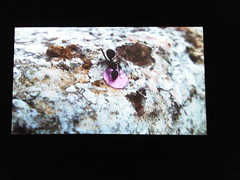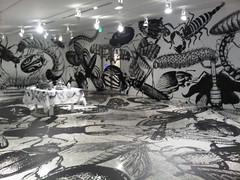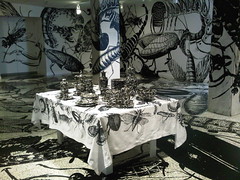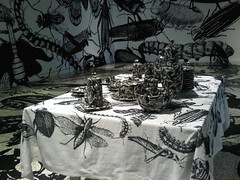
Quarta-Feira de Cinzas/Epilogue
For the blink-and-you-miss-it span of February 17-21, Quarta-Feira de Cinzas/Epilogue by Rivane Neuenschwander and Cao Guimarães was screening at The Institute of Contemporary Art as a selection in their Video Art: Replay, Part 2. The short film depicts a colony of ants collecting scattered sequins from the ground on Quarta-Feira de Cinzas (“Ash Wednesday”) against a minimal samba beat. They scamper over leafy ground, sometimes fighting over the colored discs, before pulling their booty into a dark hole. The ants also lick the sequins, surely tasting a cocktail coating of booze, salt, grime, sweat, and other unmentionable fluids. The sequins, ostensibly shed from samba dancers’ ornate costumes, represent Carnaval and all of the previous day’s debauched reveling.

Quarta-Feira de Cinzas/Epilogue
The timing was accurate, as the brief screening began on Ash Wednesday; but I don’t think that the work and its framing within this window of time translate appropriately. I say this because we do not celebrate carnaval. I was able to get in the mood a little bit, having watched some Brazilian Carnaval celebrations on Rede Globo. In Brazil, or other South American nations, this film is a no-brainer: you could show it to anyone, regardless of their background or formal education, and they would instantly “get it”. Maybe it would come off well in a city like New Orleans. But in Philadelphia, and I would think most other American cities, it falls flat because it floats divorced of a greater cultural context and awareness, which, I would argue, the filmmakers take for granted in this particular work. It simply seems fun, a little bit absurd, and possibly trifling to watch scurrying ants carrying sequins in their mandibles. Perhaps a more appropriate time to show the film in Philadelphia would be January 2, the day after The Mummer’s Parade? But so much collective hope and anticipation is placed in Carnaval, not to mention the magnitude of the collective catharsis released through it, that nothing here seems to aptly compare; do we have an event such as this? (I won’t count the Phils or Eagles winning something important—this same spirit exists in Brazil and is distinctly different from what I am grasping for here.)

Mundus Admirabilis
Interesting by comparison, though undoubtedly coincidental in its similar motif, is the work of Regina Silveira, now on display at The Galleries at Moore as part of Philagrafika 2010. Before entering Mundus Admirabilis, one must don shoe covers which shield the art, spanning the gallery walls and floor, from dirt and degradation, a fascinating paradox considering the creepy, crawly scene you are about to enter. Are we keeping pristine something already so gross, or is it we who are being offered a measure of protection from having to touch the teeming ground? Of course, I understand that this was done as conservational measure, the vinyl would certainly peel away from the floor with traffic and wear; the previous times that I had to put on shoe covers were at historic palaces in Europe with vulnerable patterned floorboards or mosaics. But I felt some kind of psychological barrier about it all, mostly because what you are about to experience, for me at least, engages in a gripping, horror vacui sensory assault. Imagine that the insects are real: what would you feel, hear, see, or even smell? Inserting a measure of prophylaxis between the viewer and a work like this make the experience more remote.

Mundus Admirabilis & Rerum Naturae
I’m not sure that I wholeheartedly embrace the Biblical end-times assertions about the work. Yes, it calls to mind Old Testament plagues. There still is something morbidly fun, cartoonish even, about the installation owing to the bugs’ exaggerated scale. I consider her insects to hew closer to the self-serious schlock of a 1950s B-movie like Them!, than the terrifyingly lethal creatures of a futuristic dystopia like in Starship Troopers. And the close layering of the vinyl forms began to abstract the insects themselves, leaving the impression of a non-representational graphic pattern the more that I gazed at it.

Rerum Naturae
Where her conceit comes off best is in Rerum Naturae, the table mid-gallery. The scale is appropriate, and the imagery is more powerful: envision your place setting crawling with bugs. Here, she mines the heart of her Brazilian unconscious, with the embroidered tablecloth and ceramic ware as spins on traditional handicraft. These items are an important part of the living cultural patrimony, available at any feira de artesanato (“handicraft market”) and found at the breakfast table of just about any home in Brazil. Her tweaking of these forms is simultaneously nauseating and beautiful, but also more subversive than the insects writ large all over the room.
No comments:
Post a Comment